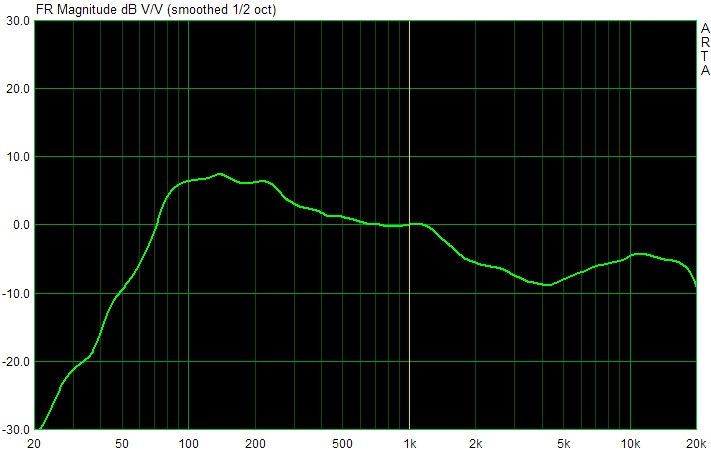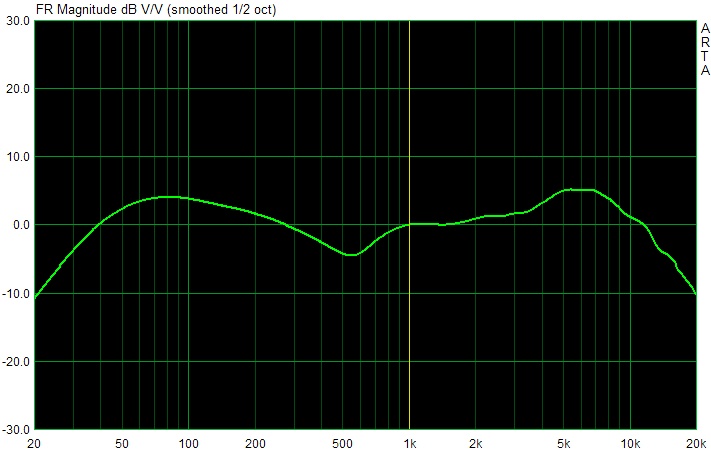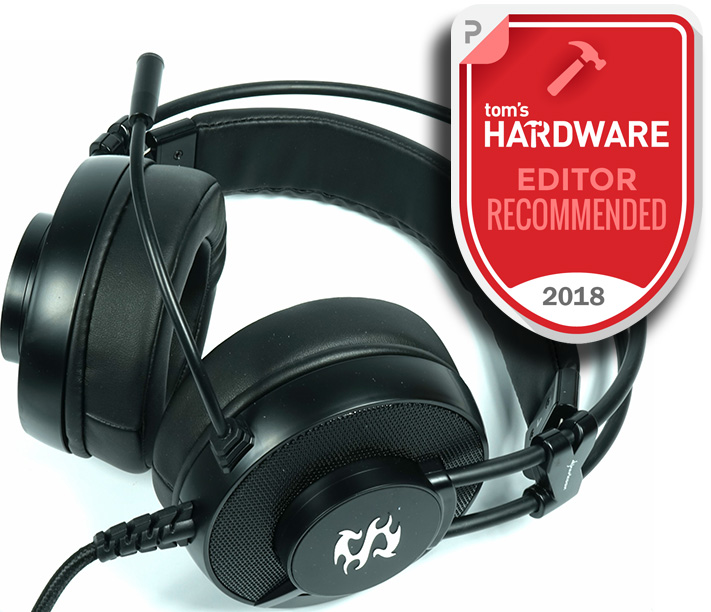Microphone
The omni-directional microphone built into a gooseneck does what it should and is supported at least by a pop and low-pass filter. The sensitivity is fine, the level strength at peaks too.

However, it is a bit bass-heavy, which gives the voice more shiny volume, but quickly also rustles up when Klaus-Kevin has already passed the voice break. Chantal-Cheyenne has it much easier when speaking up, because she always poses with her voice above this acoustic bacon belt. At 3.5 to four KHz, however, all voices fall into a small hole, which does not really do any greater damage to the intelligibility, but also somewhat tarnishes the recognition effect of the voice. There could well be some improvement here.

The level is completely sufficient and you can't swear at a nasty noise because there is none. That would be the good side of a totally average microphone, but it doesn't really do anything wrong. At the very least, we are well understood, which is actually enough.
Headphone measurement
As we test, we have already explained in the basic article "Gaming Headsets: Myth, Truth and How we Test" very detailed and transparent, because with the usual audio-swirl of bass thunderstorms and high-pitched whips you can't really get any further. You have to be able to listen subjectively well and measure at the same time. Let's start with the latter, where we only have the built-in USB solution.
For 25 euros we take the usual bath, of course. However, the slide is still quite discreet and we are not badly surprised, because in the tolerance range of 6dB at least between 25 Hz and 17 KHz you can listen in a fairly stable side position. So the 50mm drivers are obviously not that bad.
Coarser kneading attempts at the ear pad allow the curve to mutate properly in the shifting fat pads, but the belly umbilical trough of the forgotten mids remains where it is. We therefore suspect here rather a not quite ideal impedance course of the drivers, which leads to a slight drop in level. In most cases, this effect is even intentional and planned in order to help shape the bathtub tuning free of charge.

But all this, even together with the reached levels, a quite appealing resolution, an even more acceptable settling behavior and the almost neutral sound solution does not look so much like a sloppy 25 euros. This has already been completely different in two or three times as expensive headsets without a big start. Let's also test subjectively what arrives at the ear once you have figured out the perfect seat of the headset for yourself.
Bass
Test the lowest bass in the subcontraoctave (16.4 Hz to 32.7 Hz) with a recording of Bach's Toccata and Fugue in D minor (19 and 25 Hz) and the Festival Overture 1812 by Tchaikovsky (10 Hz and 12.5 Hz). The same applies to the lower ranges of the contraoctothe (32.7 to 65.4 Hz). The big bass drum (kick drum), which in the U-music is a welcome companion and usually on approx. 55 to 60 Hz, this assessment will then be rounded off.
The very warm low(st)bass has, despite a slight drop in level below approx. 35 Hz, always presence and a very good resolution for this price range. The subcontraoctave is audible, which is not self-evident. From approx. 50 Hz the bass seems a little louder and more dominant, which should certainly not be uncommon for the target group. This rather bass-focused vote is a matter of taste, but one can at least live with it (over), because in return it was not exaggerated.
Despite the very soft bass interpretation of the system, the large bass drum still comes across sufficiently crisp and the level strength with short but dominant impulses is also correct. Sound effect traces in earthquake-catastrophe videos or other cinematic heroics can become an acoustic pleasure without the drivers' membranes constantly hitting the cover.
The upper bass up to 150 Hz, in which also the Great Octave (65.4 to 130.8 Hz) is located, houses the basic language frequency of the male voice and decides very strongly on the true-to-life reproduction of male vocals.
This area sounds a bit fattened. The male vocals are played very rich and warm, the instruments are only slightly distorted. Overall, the resolution is still acceptable in this area and does not allow sources playing too dominantly to perform quite well. Location of belligerent Peng, Plopp and Krawumm also works, test passed until here.
Frequency range
The lower middles (also basic tone range) are approx. 150 to 400 Hz. Together with the already mentioned upper bass, this area plays a very important role for the subjectively perceived heat or bass. Fullness of the sound. The basic language frequency of female voices can be found in this area.
Female vocals come to the point amazingly clean. The timbre of the vocals and recorded instruments always remains rather warm and beautifully full, down almost a little too baroque. Here, however, you can already hear the sloping flanks of the center hole upwards. With a ticket price of 25 Euros for the concert, this is not even a drama with classical music, because even in real life you only get the seat for which you also pay. But at least you don't sit behind a pillar, promised.
The upper mids between 400 Hz and about two KHz contain a mark at a KHz, which is still considered a reference for many measurements. Unfortunately, this is often noticeable with cheaper devices, as manufacturers often try to overemphasize this frequency. This area does not play an insignificant role in gaming either, and balanced playback contributes significantly to good spatial resolution.
The drama is about. 550 Hz. With many instruments, certain nuances weaken and also the resolution suffers a little for experienced ears. Some details are blurred or even go under a little. The stage and the subjectively perceived quality of the spatial resolution, on the other hand, are usable and at least at a 50-euro level.
A large orchestra also seems to have a long enough position, even if individual, rather quieter sources cannot always be located with real certainty. You have to be aware of this at this price. But for Otto average listeners and especially for Kevin-Klaus Gamer, the bidding is enough.
High-pitched range
Between two and about 3.5 KHz, human hearing is most sensitive, especially since this area of the lower heights is responsible for the good overtone reproduction of the human voice. This frequency range is crucial for the recognition of a voice or instrument; in this context, one also speaks of the respective timbre.
The location in the game is now at the height of the action at all times, without any undesirable level drop disturbing us now. In places, this is even playback at a significantly higher price level. Spatiality is possible even without the additional 7.1 paste, if you do not cover anything mechanically or improve DSP-worsening. To be fair, the headset has to be allowed to do that at this point. Also the music reproduction weakens only a little and we have heard a lot of it much worse.
The middle heights (3.5 to six KHz) decide on the sound or failure of the speech reproduction as a whole, because the S- and hissing (Sibilants) fall into this range. The upper heights then reach up to approx. ten KHz to move into the super high tone.
High and super high tone are very pronounced without directly overburdening. There is nothing drifting into the metallic and the tip, but over-concrete sibilants and blow-out noises are a small topic on the margins. Not very dramatic, but a little too superficial. If you play nasty MP3 files that are fried by the compressor, you will get little needles in the eardrum with a little bad luck, but otherwise everything is good. The resolution is really acceptable and more appropriate to the final price.

Summary and conclusion
If we exclude a certain, booked minimum shelf life date by the accounting lyre of the material selection, then here on the table there is a kind of price-performance winner, to whom the result of the measurements and the rehearsal in this form is probably would not have trusted at all. Sharkoon saved quite cleverly at the Skiller SGH2 exactly where you see it less and even don't hear it. You didn't save on the driver, but on excess fluids like full RGB, software and more expensive USB controller.
Accessories? You don't need it anyway. Software and drivers? Thank God it's possible without, just by plug-and-play. Noise? Negligible. Defects? Well, at 25 euros you will also be mild as a tester. Nevertheless, one should then perform the rather wobbly ear pads, the plastic-heavy mechanics, which can certainly not have eternal life, and the lack of optical conspicuousness that some would like so much as a skill amplifier. After all, you can make blue with it and you don't sit completely in the dark.
The USB sound solution from C-Media is not an acoustic highlight together with the 50mm neodymium drivers, but it is also not a musical dive bomber of the Chinese People's Army. Solid, without real corners and edges and always full of service enough to do even what it is supposed to do. But at least that's right.
For the sound, which is never as cheap as the price actually implies, there is also the purchase tip, because in this price range the Skiller SGH2 is almost unbeatable. It is therefore the acoustic lifeline of the little man, who is too much more money for the audio and who still does not want to suffer a hearing crash.






























Kommentieren